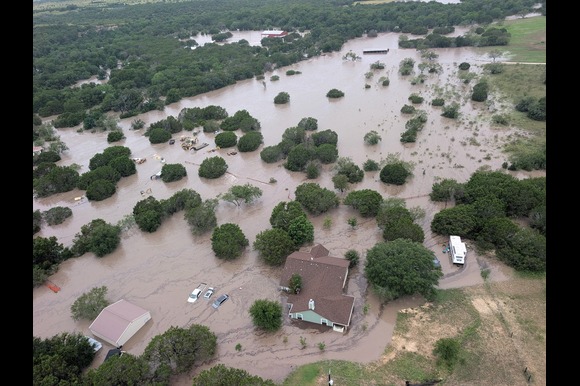
By Unknown author
The death toll from devastating floods in Texas has climbed to over 100 as emergency crews persist in a difficult search for people still missing after flash floods swept across central parts of the state over the Fourth of July holiday weekend.
Among the dead are at least 27 young girls and camp counselors who were staying at a Christian summer camp on the banks of the Guadalupe River when the deluge struck. The fatalities occurred amid what officials are calling one of the worst natural disasters to hit the state in decades.
Forecasters have warned that the threat is far from over, with more rain expected to fall on already saturated terrain, potentially causing further flash flooding. Ongoing rescue and recovery operations involve helicopters, search dogs, boats, and more than 1,750 personnel.
“There remains a significant risk of heavy rainfall capable of triggering further flooding,” Texas Governor Greg Abbott stated on Monday. He warned that the death toll may rise further as search and rescue teams comb the affected areas.
President Donald Trump announced plans to visit Texas on Friday, amid backlash over his administration’s budget cuts to weather and emergency agencies. The White House forcefully rejected the criticism.
“To blame President Trump for these floods is a depraved lie and distracts from the mourning that families are experiencing across Texas,” White House Press Secretary Karoline Leavitt said Monday. She added that the National Weather Service (NWS), despite reports of staffing shortages in the region, provided “timely and accurate forecasts and alerts.”
Trump characterized the flooding, which began in the early hours of Friday, as a “100-year catastrophe” that “nobody could have predicted.” The president, who has previously argued that disaster relief should be the responsibility of individual states, has now issued a major disaster declaration. The declaration unlocks additional federal funding and resources to aid in the recovery.
‘Unthinkable Tragedy’
Authorities have confirmed at least 104 flood-related fatalities across central Texas, with Kerr County — where the Guadalupe River cuts through — suffering the most devastating losses. At least 84 people have died in the county, including 28 children.
Among the victims were 27 girls and camp counselors from Camp Mystic, a long-standing all-girls Christian camp that was hosting around 750 attendees when the river overflowed its banks. Summer camps, a cherished American tradition, often take place in remote wooded areas, which left many vulnerable during the disaster.
Texas Senator Ted Cruz mourned the loss, describing summer camps as a place where children create “lifelong friendships — and then in an instant, it all turns into tragedy.”
Still, questions are growing among Texas residents over the apparent absence of a robust flood-alert system in a region that has long been dubbed “Flash Flood Alley” due to its frequent and dangerous deluges.
While meteorologists and NWS officials say timely warnings were issued, climate scientist Daniel Swain pointed to a failure in the dissemination of alerts — with not enough people receiving or reacting to them.
Nicole Wilson, a San Antonio mother who had considered sending her daughters to Camp Mystic, has launched a petition demanding that Governor Abbott invest in a modern emergency warning network. “Five minutes of that siren could have saved every single one of those children,” Wilson told AFP.
On Monday night, a candlelight vigil in San Antonio brought hundreds together in prayer and remembrance, as well as to express anxiety about future disasters.
“I was shocked at how quickly the rivers rose — I never imagined it could happen like this,” said 29-year-old Rebeca Gutierrez. “I just hope something is done to prevent a tragedy like this from repeating elsewhere.”
Power of Nature on Display
The flooding along the Guadalupe River illustrated nature’s devastating power in harrowing detail. As the girls at Camp Mystic slept, the river rapidly rose, with water levels reaching the treetops and submerging the rooftops of cabins.
Rescue teams found shattered windows, mud-covered teddy bears, blankets, and children’s belongings strewn across the area. The overwhelming surge of water reportedly broke through structures with violent force.
Volunteers, many with personal ties to the missing, joined the search. “We’re helping the parents of two of the girls who are still missing,” said 62-year-old Louis Deppe. “The last thing they heard was, ‘We’re being washed away,’ before the call went dead.”
The flooding was triggered by an extraordinary weather event, with several months’ worth of rainfall descending in just a few hours between Thursday night and Friday morning. The Guadalupe River surged 26 feet — the height of a two-story building — in only 45 minutes.
Flash floods occur when the ground cannot absorb intense rainfall, and scientists say human-caused climate change is making such extreme weather events more frequent and severe. In recent years, Texas has faced increasing threats from flooding, droughts, and heat waves, all linked to a warming climate.
As Texas begins a long and painful recovery, calls for systemic changes in disaster preparedness — including better warning systems and climate adaptation — are growing louder, echoing the grief and urgency felt throughout the state.




